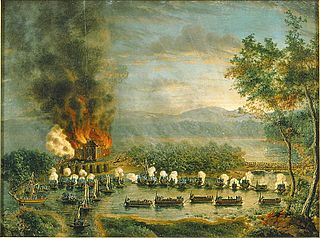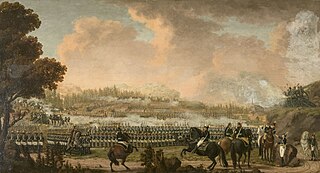 W
WThe Battle of Björkösund took place on July 2–3, 1790 during Russo-Swedish War (1788–90), between Sweden and the Russian Empire. The Russians, who had the navy of their Swedish opponents along with their Archipelago fleet trapped inside the Vyborg Bay, planned to attack the Swedish ships from different directions causing a decisive defeat on its navy before the wind would allow them to escape the trap. On the night of July 2–3 the attack was commenced by Karl Heinrich von Nassau-Siegen who, with his coastal fleet of 81 ships of various sizes, sailed to meet with the Swedes stationed at the eastern strait of Björkösund. The Swedes with three divisions of mostly gun sloops and yawls under Lieutenant colonel Klas Hjelmstierna with major Leijonankar and captain Scharff assisting in their divisions, had about 42 boats under their command. The strait beside the island of Kantasari, from which the Russians had to attack through, was narrow and was met with fierce fire at 23:00 on July 2 by the Swedish vessels. The fighting continued until 04:00 on July 3, until the Swedish Lieutenant received orders to fall back to the main Swedish ships as the breakthrough from Vyborg Bay was about to begin. A squadron of Lieutenant colonel Stedingk consisting of turumas was initially left to cover their withdrawal, but as the Russians chose not to pursue, they as well went off to the main Swedish vessels. In the battle the Swedes lost only 3 killed and another 8 wounded. The Russians, on the other hand lost up to 400 men killed and wounded according to their own numbers provided by captives after the battle of Svensksund, as well as one frigate and one xebec another larger ship was also lost along with some smaller ones. The Swedes were successful in that they managed to hold off the Russian coastal fleet long enough for the preparations for the breakthrough to be set and so, on July 3, Gustav III of Sweden and his navy finally broke out, although with heavy losses.
 W
WThe Battle of Elgsö took place on September 30, 1789 during Russo-Swedish War (1788–90), Sweden won over the Russian Empire.
 W
WThe Battle of Kvistrum or the Battle of Kvistrum bridge took place on September 29, 1788 during the Theatre War, a phase of the Russo-Swedish War (1788–90), between Sweden and the Denmark–Norway. The Swedes lost the battle and had five killed and the rest captured with 60 wounded, the Danes and Norwegians had suffered 5 killed and 16 wounded.
 W
WThe Pardakoski–Kärnakoski took place on April 30, 1790 during Gustav III's Russian War, Sweden won over the Russian Empire.
 W
WThe Battle of Uransari or the Battle of Kachis Capel took place on June 16, 1790 during the Russo-Swedish War (1788–1790). The battle was part of a larger Swedish military operation aiming to destroy the Russian Baltic Fleet, anchored deeper into the Vyborg Bay, at Vysotsk. For this task, Gustav III of Sweden ordered three divisions of the Swedish Navy and Archipelago fleet to penetrate the narrow passages, which were guarded by Russian coastal batteries. William Sidney Smith, an Englishman, commanded the right Swedish division which encountered a battery at the edge of the Uransari island, called Kachis Capel. The Swedish forces consisted of the yacht Aurora, four gun longboats, 38 gun sloops and yawls, and 160-200 men of the Svea Life Guards loaded into four landing crafts; all in all close to, or around, 2,000 men. The Russians had a coastal battery and about 700 men in the vicinity; among them the Russian Imperial Guards. After about an hour of artillery duel the Russian coastal battery exploded, by which time the Swedish guards landed on the island. After a short struggle the Russian guards retreated, with a loss of four men killed and 26-28 captured. A further 55 Russians fell at the battery itself. The Swedish guards lost fifteen dead and wounded in the action, while the fleet lost seven; in total, four men dead and eighteen wounded. The battle had no strategic effect as the other Swedish divisions had not sailed out accordingly due to bad weather, and Smith, being unsupported, was soon driven off the island by the Russians. The operation was later cancelled all together by the Swedish king in preparation to break out the Russian blockage. Some days later the Russians made an unsuccessful attempt at destroying the Swedish Archipelago fleet in the Battle of Björkösund. The Swedes managed to break out and escape at the Battle of Vyborg Bay the day after, but with heavy losses. The two sides then faced each other in the decisive Battle of Svensksund, which marked the ending of the war.
 W
WThe Battle of Uttismalm took place on June 28, 1789 during Gustav III's Russian War, Sweden won over the Russian Empire.
 W
WBattle of Valkeala took place in Gustav III's Russian War April 29, 1790 at Valkeala in Kymenlaakso in Southern Finland and ended with a Swedish victory.